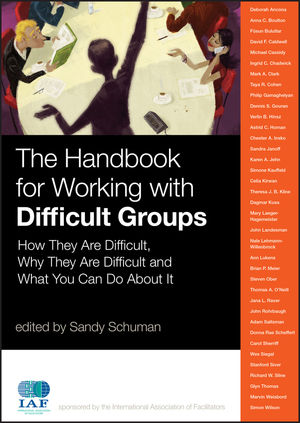The Handbook for Working with Difficult Groups: How They Are Difficult, Why They Are Difficult and What You Can Do About ItISBN: 978-0-470-19038-8
Hardcover
480 pages
April 2010, Jossey-Bass
 This is a Print-on-Demand title. It will be printed specifically to fill your order. Please allow an additional 10-15 days delivery time. The book is not returnable.
|
||||||
About the Contributors.
Introduction: Working with Difficult Groups: A Conceptual Framework.
Make sense out of what makes working with groups difficult (Sandor Schuman and John Rohrbaugh).
1 Keeping Difficult Situations from Becoming Difficult Groups.
Dissenters need support, or the group risks going off track (Marvin Weisbord and Sandra Janoff).
2 Building an External Focus: Avoiding the Difficulties on an In-grown Team.
The critical importance of an external perspective (Deborah Ancona and David F. Caldwell).
3 The Downside of Communication: Complaining Cycles in Group Discussions.
Help teams get out of the “complaining loop” and turn to solution-oriented interaction instead (Nale Lehmann-Willenbrock and Simone Kauffeld).
4 Facilitating Multicultural Groups.
Customize structures and processes to match groups' cultural preferences (Donna Rae Scheffert and Mary Laeger-Hagemeister).
5 Interpersonally Hostile Work Groups: Precipitating Factors and Solutions.
A group perspective on workplace harassment and bullying is essential to understanding and preventing it (Jana L. Raver and Ingrid C. Chadwick).
6 Diversity by Design: Creating Cognitive Conflict to Enhance Group Performance.
Ill defined, diversity might undermine its purpose (Michael Cassidy).
7 Facilitating Inclusion: Study Circles on Diversity and Student Achievement.
Bridging differences in culture and ethnicity can foster academic achievement (Mark A. Clark and John Landesman).
8 Overcoming Sources of Irrationality That Complicate Working in Decision-Making Groups.
Six factors make working with this group difficult in many different ways (Dennis S. Gouran).
9 Working Without Rules: A Team in Need of a Different Picture.
Affirmative language encourages new views of a team's past and future (Ann Lukens).
10 Interaction Archetypes: Keys to Group Difficulty and Productivity.
Identify the repetitive behavioral sequences that reduce a group's ability to produce results (Steven Ober).
11 Virtual Teams: Difficult in All Dimensions.
Group members working virtually and interdependently face enormous challenges (Thomas A. O’Neill and Theresa J. B. Kline).
12 Politics of the Arts: Challenges in Working with Nonprofit Boards.
A “confessional tale”—lessons learned while facilitating an arts board in transition (Richard W. Sline and Anna C. Boulton).
13 Competitive Group Interactions: Why They Exist and How to Overcome Them.
Groups are less cooperative than individuals—learn how you can reduce intergroup conflict (Taya R. Cohen, Brian P. Meier, Verlin B. Hinsz, and Chester A. Insko).
14 Active Facilitation: How to Help Groups Break Through “Mutual Stalemate”.
Groups may abdicate their responsibilities waiting until another group makes the first move (Celia Kirwan and Wes Siegal).
15 Mediating History, Making Peace: Dealing with the “Messy” Stuff in the Conciliation Process.
Identity-based conflicts will not achieve long-term solutions through resource-based settlements (Dagmar Kusa, Adam Saltsman, and Philip Gamaghelyan).
16 Deep Democracy: Multidimensional Process-Oriented Leadership.
Learn to track the shifting roles of group members (Stanford Siver).
17 Authentic Relationships and Collective Psychological Capital.
How leader behavior can undermine group success (Füsun Bulutlar).
18 How Leaders Can Make Diverse Groups Less Difficult: The Role of Attitudes and Perceptions of Diversity.
Perceptions that lead to subgrouping can override the positive effects of diversity (Astrid C. Homan and Karen A. Jehn).
19The Hero's Journey: Helping Inflexible Groups—and Inflexible Facilitators—Get Unstuck.
Use the Hero's Journey as an analytical and facilitation tool to help groups and facilitators get out of difficulties (Carol Sherriff and Simon Wilson).
20 Difficult Groups or Difficult Facilitators? Three Steps. Facilitators Can Take to Make Sure They Are Not the Problem.
Facilitators can unknowingly contribute to the difficulties their group’s experience (Glyn Thomas).
Key Terms.
References.
Name Index.
Subject Index.



